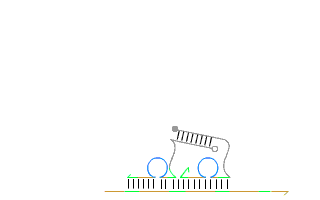The molecule DNA has emerged as the building block of choice for making precise, self-assembled nanoscale structures (in the laboratory, at least) – the specificity of the base-pair interaction makes it possible to design DNA sequences which will spontaneously form rather intricate structures. The field was founded by NYU’s Nadrian Seeman; I’ve written here before about DNA nanostructures from Erik Winfree and Paul Rothemund at Caltech, and Andrew Turberfield at Oxford. Now from Turberfield’s group comes a paper showing that DNA has the potential not just to make static structures, but to make functioning machines.
The paper, Coordinated Chemomechanical Cycles: A Mechanism for Autonomous Molecular Motion (abstract, subscription required for full article), by Simon Green, Jonathan Bath and Andrew Turberfield , was published in Physical Review Letters a couple of weeks ago (see also this Physical Review Focus article). The aim of the research was to design a synthetic analogue of the molecular motors that are so important in biology – these convert chemical energy (in biology, typically from a fuel like the energy carrying molecule ATP) into mechanical energy. One important class of biological motors consists of something like a molecular walker which moves along a track – for example, the motor molecule myosin walks along an actin track to make our muscles contract, while kinesin walks along the microtubule network inside a cell to deliver molecules to where they are needed (to see how this works take a look at this video from Ron Vale at UCSF). What Turberfield’s group has demonstrated is a synthetic DNA based motor that walks along a DNA track when fed with a chemical fuel.
The way molecular motors work is very different to any motor we know about in our macroscopic world. They’re the archetypal “soft machines”, whose operation depends on the constant Brownian motion of the wet nanoscale world. The animation below shows a schematic of the motor cycle of the DNA motor. At rest, the motor is stuck down by both feet onto the track, which is also made of DNA. The first step is that a fuel molecule displaces one foot from the track; the foot part of the motor then catalyses the combination of this fuel molecule with another fuel molecule from the solution, releasing some chemical energy in the process. The foot is then free to bind back to the track again. The key point is that all these binding and unbinding events, together with the flexing of the components of the motor that allow it to pick up and put down its feet on the track are driven by the random buffetings of Brownian motion. What makes it work as a motor is the fact that there’s an asymmetry to which foot is more likely to be displaced from the track; when the foot sticks back each of the two possible positions is equally probable. This means that although each step in the motor is probabalistic, not deterministic, there’s a net movement, on average, in one direction. It’s the input of chemical energy of the fuel that breaks the symmetry between forward and backward motion, making this motor a physical realisation of a “Brownian ratchet”.
In this paper the authors don’t directly show the motor in action – rather, they demonstrate experimentally the presence of the various bound and unbound states. But this does allow them to make a good estimate of the forces that the motor can be expected to exert – a few picoNewtons, very much in the ball-park of the forces exerted by biological motors.

Schematic showing the operation of the DNA motor. Animation by Jonathan Bath.
There has also been a fair amount of work being done on electrically powered nanomotors, and its design is much more of a traditional engineering approach (it looks like a water wheel) rather than the soft machine approach.
http://nanotechweb.org/cws/article/tech/36611
Jim, the Kral paper is nice: it’s particularly good that they’ve done the simulations at finite temperature and got good estimates of dissipation and efficiency. But for the moment, it’s entirely theory, and I think it’s very difficult to see at the moment how you would build such a motor.
Baby steps, Dr Jones, Baby steps.
Do you think this motor design meets one of your MNT challenges ? (design a nanomotor)
As far as building the device, making the parts looks quite doable (the shaft, the blades, the electrodes). The biggest problem (as far as I can tell) is putting the blades on the shaft. And that is a variant of the general problem of how to functionalize the end of an open carbon nanotube. And functionalizing the ends of carbon nanotubes is an area of active research.
Building something like this electrically powered nanomotor could be an ambitious goal for an imaginative and talented nanotech research center. (I hear you have a couple of them in the UK 😉
Yes, this is certainly in the area of the nanomotor MNT challenge. I’d be very interested to see an experimental effort in this area.